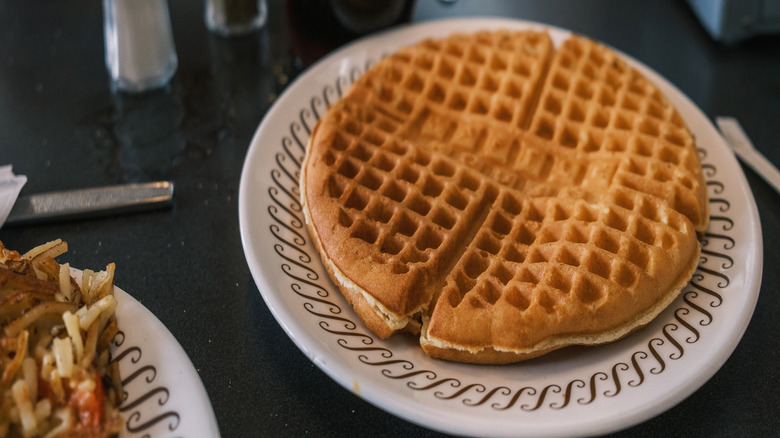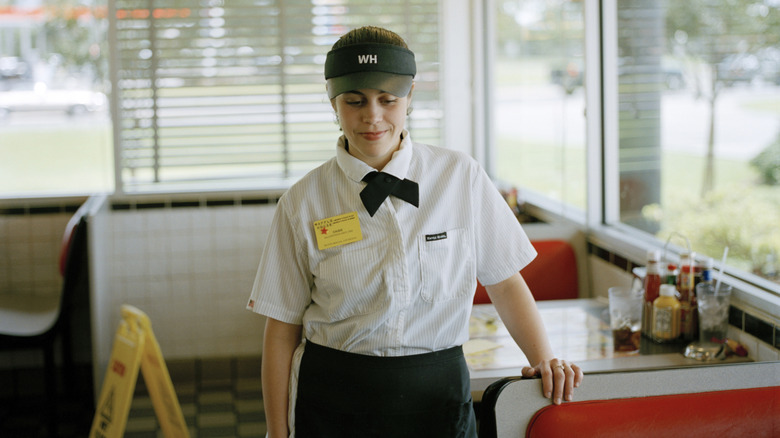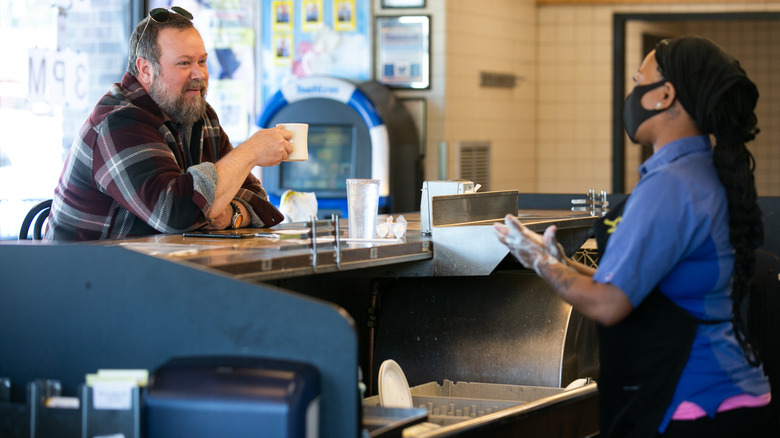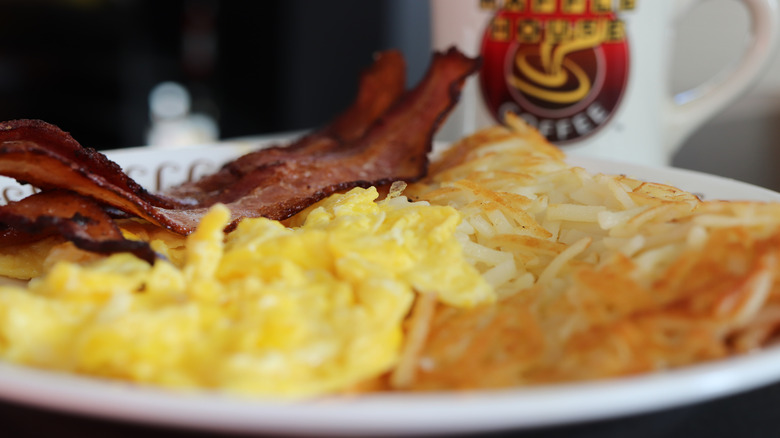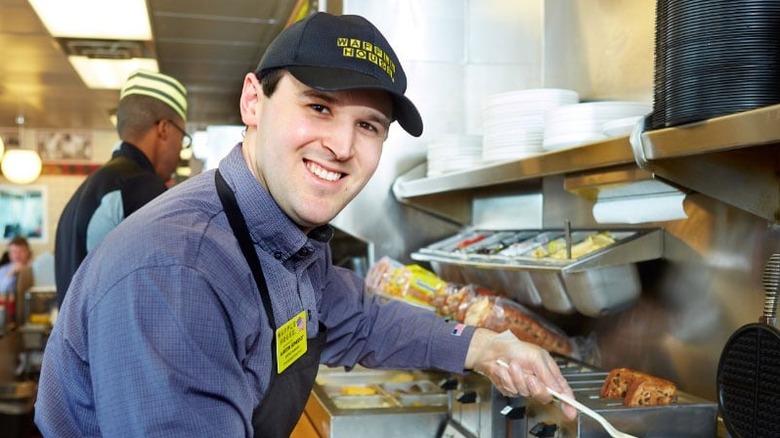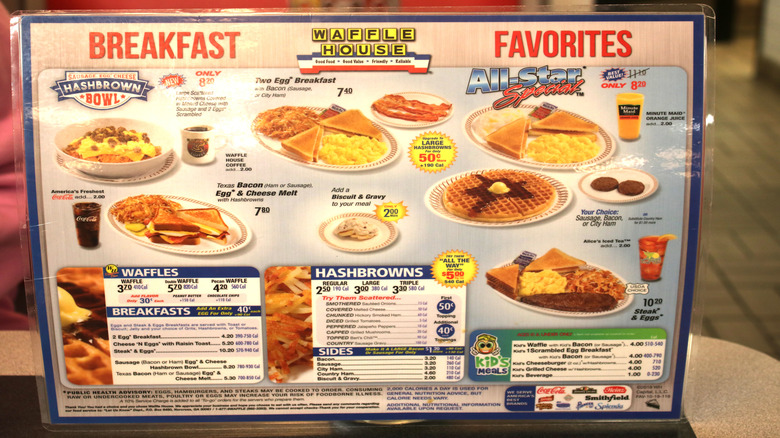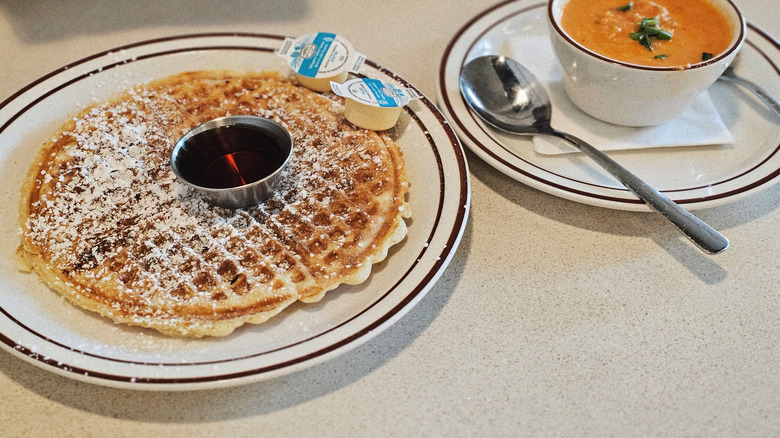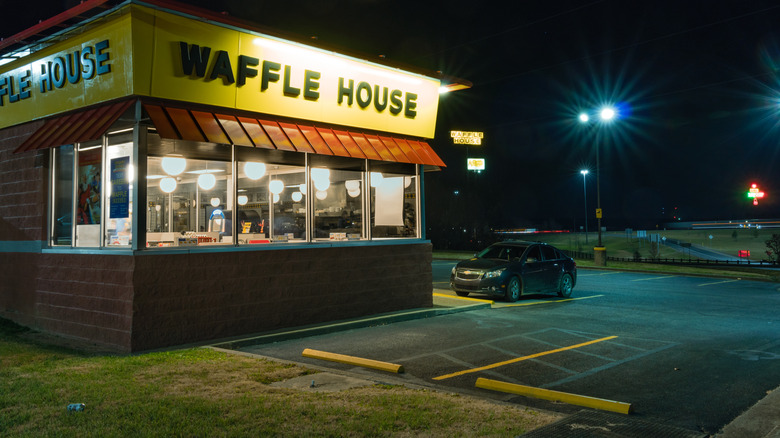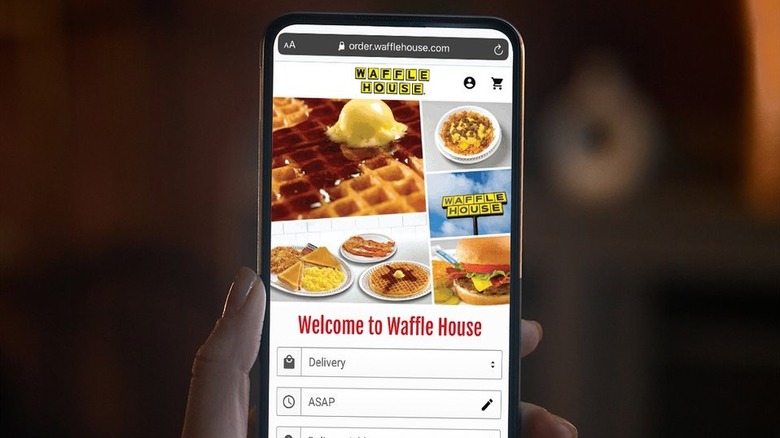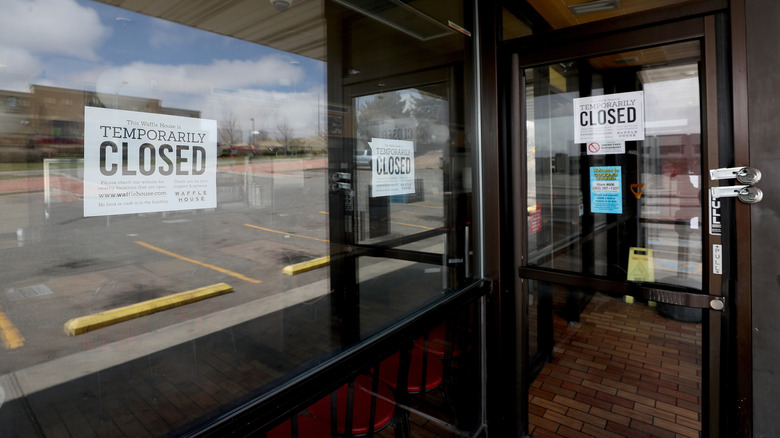The 11 Waffle House Unwritten Rules You Need To Know
In the pantheon of American culinary institutions, few are as revered, as resilient, and as brilliantly idiosyncratic as Waffle House. The magic of the place goes far beyond fluffy waffles and hash browns. It's a cultural phenomenon rooted in a simple founding principle: "We aren't in the food business. We're in the people business." When neighbors Joe Rogers Sr. and Tom Forkner opened their first 24-hour restaurant in 1955, they focused squarely on the community — both the associates behind the counter and the customers in the booths.
This foundational commitment to people over profit created a unique environment where culture could flourish organically. Over nearly seven decades of expansion to over 2,000 locations, the relentless rhythm of 24/7 service and the equitable nature of serving everyone from night-shift workers to celebrities shaped an unspoken set of rules. The famous "yellow sign" became a landmark that represents a quintessential Southern dining experience where this code of conduct evolved from the beautiful, chaotic reality of the operation.
That's why Anthony Bourdain famously preferred it to The French Laundry. He wasn't just there for the food, but for the pure, unfiltered honesty of the place. The unwritten rules, like knowing solo diners sit at the counter or understanding jukebox etiquette, aren't posted anywhere. This etiquette manifested from the natural order of millions of diner meals delivered, proof that Waffle House mastered something rare: a space where everyone, intuitively, knows how to belong.
All patrons are created equal
The unwavering democracy of Waffle House is not preached but practiced, shaped in the fluorescent-lit reality of its sleepless operation. The design itself is a profound social leveler: an open grill where every order is public, a counter that seats strangers shoulder-to-shoulder, and a menu that offers the same affordable comfort to all. This isn't a place where hierarchies can be maintained; it's a great equalizer where the night-shift nurse, the late-night partier, and the early-rising executive all converge for the same simple purpose: a reliable meal served without judgment. The environment itself enforces the rule that everyone is simply a customer.
The holistic culture of the Waffle House plays out in the subtle details of the diner experience. The caddies on every table offer the same condiments to every patron, the jukebox plays the same tunes regardless of who makes the selection, and the laminated tables have supported elbows from all walks of life. There are no VIP sections or premium menus, just the consistent comfort of approachable, quality food served around the clock. This steadfast commitment to equal treatment has made Waffle House one of America's most accepting spaces, where your place in the social hierarchy matters far less than your ability to properly order your hash browns according to house lingo.
Mind your manners
At Waffle House, the mandate for basic decency — the "yes ma'am," "no sir," and patience your mama drilled into you — is more than mere social grace. It is the essential lubricant for a machine that runs on tipped wages and human grit. This expectation is a pragmatic response to the economic reality of diner labor: The person refilling your coffee is likely paying for the privilege of their shift meal, investing in non-slip shoes, and commuting to a job where their income hinges on the generosity of strangers. Your manners are both a courtesy and a requirement.
This dynamic fosters a unique form of teamwork and pride. Despite the financial challenges, many associates find deep satisfaction in the pace of the diner — the sense of completion from a clean stack of plates, the camaraderie with regulars, and the mastery of a complex ordering system. The unspoken rule to keep your cool, hold your liquor, and simply lead with kindness is therefore a pact of mutual respect. It recognizes that the staff's ability to perform under pressure is fueled by a genuine dedication to their craft and their community. To mind your manners is to uphold that grind and contribute to the delicate balance that keeps the doors open and the hot plates flowing.
Solo diners belong at the counter
The unwritten rule that solo patrons belong at the counter is a masterstroke of operational genius, a tradition born from Waffle House's enduring focus on efficiency and community. In a non-stop environment where space is perpetually at a premium, this simple etiquette ensures that larger parties can always find a booth. But what began as a practical solution has evolved into the quintessential Waffle House experience. The counter is the venue's beating heart, offering an immersive, front-row view of the grill's orchestrated chaos and facilitating the kind of spontaneous, genuine interaction that was central to the founders' philosophy.
This practice also perfectly aligns with the growing culture of the solo diner, who seeks not just a meal but an authentic connection to their surroundings. By taking a stool, a lone customer becomes part of the show, a spectator to the short-order dance, and a potential conversational partner for the staff. It transforms a simple bite into a moment of community, upholding the diner's momentum while offering the individual a seat at the most interesting table in the house. This self-policing rule reveals how Waffle House's systems naturally foster both efficiency and a unique brand of human connection.
Learn the hash brown lingo
The need to learn the hash brown lingo is perhaps the most delicious rite of passage at Waffle House, a linguistic tradition forged in the operational fires of the flat-top griddle. This wasn't a marketing creation but a necessary evolution from the chain's earliest days, a direct response to the hectic pace and the need for flawless communication between server and cook. Terms like "scattered" (on the grill), "smothered" (with onions), and "covered" (with cheese) form a precise, efficient vocabulary that prevents frenzy during a rush. This vernacular is the verbal engine of the people-first business model, ensuring that the focus remains on speed and accuracy for every customer, from the pre-dawn regular to the post-concert celebrity.
Customizing your hash browns is key to the Waffle House culture. To fluently order your hash browns "chunked" (with ham) and "capped" (with mushrooms) is to demonstrate that you understand and respect the establishment's intricate way. This shared language creates an immediate, unspoken bond between the patron and the staff, signaling that you are a participant in the process. It is the ultimate sign of a regular: A small but significant act that honors the history and operational brilliance behind this infamous diner. In a world of digital menus and silent transactions, this shouted shorthand keeps the human connection at the heart of the Waffle House experience.
The grill code is law
Watch the Waffle House grill during the peak of a lunch rush, or glimpse a viral corporate training video, and you'll witness a study in corporate efficiency (albeit a delicious one). This precision is governed by an unspoken doctrine known simply as "the grill code," a sophisticated system of verbal calls and silent plate markings that functions as the kitchen's central nervous system. The verbal component, known as "Pull, Drop, Mark," orchestrates the cook's movements with rhythmic precision, while a separate, hidden lexicon of plate markings – a packet of brown sugar placed atop a napkin, two pickles placed to the right of a plate — silently guides servers on customizations. This dual-channel communication is the operational backbone, ensuring that an "all the way" order for one patron arrives simultaneously with a "well-done T-bone" for another.
Born from the practical demands of a never-ending operation, this language ensures efficiency and accuracy in an environment where every second counts. The code is also non-negotiable. Its flow, perfected over generations, allows a small team to execute a staggering volume of customized orders with flawless accuracy. There's no need to question a call or misinterpret a plate marking, else you might upset the careful choreography. The grill code empowers the staff, granting them dignified command over their domain and transforming the potential for pandemonium into a steady stream of sizzling plates. It is, in essence, the ultimate sign of respect for the craft of short-order cooking, ensuring that the promise of extra crispy hash browns is adhered to with every single order.
Fresh food can't be rushed
The principle that fresh food can't be rushed is a cornerstone of the Waffle House operation. This practice is rooted in the original vision for the diner, a business where honest eats and genuine service are top priorities. Every egg cracked and every waffle poured to order is a direct reflection of this ethos, ensuring that the "good food" part of the company's "Good Food Fast" motto is never compromised for speed. This creates an inherent contract of patience with the customer, who understands that the wait is the signature of a meal rightly prepared.
This unwavering dedication to a deliberate pace has made Waffle House an unlikely case study in reliability. The chain's robust, round-the-clock operational model is so effective that it has been studied by entities ranging from corporate strategists to religious ministries, who see in its resilience a blueprint for perseverance and faith in a system. In a world of shortcuts, Waffle House's success proves a powerful lesson: That steadfast commitment to a core process, no matter how simple, can build an institution that stands the test of time. That wait for your food isn't a delay; it's proof that the system works.
Hack your order when it's slow
The culture of "hacking" your Waffle House order — from creating waffle tacos and meat tacos to a full-on hash brown waffle sandwich – represents a fascinating evolution of the chain's founding principle. While Joe and Tom built their business on consistency, they also championed a flexible, human-centric service. This inherent flexibility, designed to accommodate a regular's specific cravings, has found a new expression in the social media age. Platforms like TikTok have turned creative off-menu requests into a viral art form, showcasing the brand's surprising capacity for customization within its famously efficient system.
The crucial unwritten rule here is timing. These culinary experiments are best reserved for slower shifts, a courtesy that respects the operational reality behind the counter. During a calm afternoon or a late-night lull, the grill operator likely has the mental space and time to collaborate on a unique creation without disrupting the delicate dance of the rush. This practice is a joyful adornment to the diner's core identity: A place that values human connection enough to occasionally bend its own rules. And even if you don't get the chance to order off-menu, you can always attempt to make the internet-famous Heart Attack patty melt at home.
Your jukebox choices affect everyone
The Waffle House jukebox operates under a simple but firm social contract: It is a shared stage, not a private playlist. This understanding is baked into the diner's culture, where the comfort of the collective takes precedence over any individual's whim. The specialized consoles, often loaded with songs from Waffle House's own record label, act as an entertaining barometer of the room's vibe. This is why the most critical audio rules — no repeats, no abandoning a long queue of songs, and always reading the room — are enforced by the staff's inherent right to maintain a harmonious atmosphere.
This system of musical self-governance is what separates regulars from newcomers. A well-chosen song can elevate the late-night energy, while a tone-deaf selection can throw off its harmony. The staff's authority to unplug the machine is the ultimate check on this power, a reflection of their role as stewards of the overall experience. Choose a song thoughtfully, and you'll get to participate in a decades-old tradition of communal respect. It's a small but significant act that acknowledges you are part of a temporary community, all sharing the same space and the same soundtrack.
Navigate the night shift carefully
There is a Waffle House that exists in the wee hours of the morning that operates by a different set of rules. This is the "warrior shift," a period that has earned its reputation through decades of serving a unique cross-section of night owls, midnight laborers, and post-bar crowds. The heightened energy presents as a myth by day and a reality each night. It's the natural result of a pressure cooker environment where sleep deprivation and high emotions converge. Over time, a simple survival guide has emerged for patrons: Keep your head down, avoid unnecessary confrontations, and understand that the usual social contracts are tempered by the late hour.
This is more about situational awareness than it is fear (we love going to the Waffle House at all hours). The staff working these shifts are veterans of this singular establishment, and they possess a finely tuned radar for trouble. Your role as a customer is to be a respectful observer, not an instigator. The goal is to enjoy your cheesy eggs and hash browns without becoming part of the evening's drama. Success means leaving at sunrise with nothing more than the story of a satisfying meal, not one you have to defend. This unwritten rule is a salute to the staff who maintain order amid action, and a nod to the raw, unfiltered version of America that comes out after dark.
Keep it moving after you've eaten
The mandate to settle up and move on after your meal is a fundamental tenet of Waffle House etiquette. This establishment operates as a culinary pit stop, not a destination for lingering — a crucial distinction that ensures its readiness for the round-the-clock parade of patrons. The recent addition of digital pay options only reinforces this principle, making a swift exit more efficient than ever. While the atmosphere is unequivocally welcoming, the understanding is implicit: savor your meal, gracefully surrender your seat, and pay on your way out. The sole exception to this rule is the legendary "24-hour challenge," a viral marathon dining session undertaken only with the explicit approval of the staff.
This culture of efficient turnover is what allows Waffle House to fulfill its role as a reliable public utility. The pulse of the diner depends on steady movement, and lounging undermines the efficient flow that keeps wait times down and coffee fresh. It's a simple understanding that respects both the staff's pace and the needs of fellow patrons. This rule exists not to hurry customers, but to maintain the rhythm that makes the diner work for everyone. Your timely departure is the final, courteous act of a proper Waffle House visit.
Closed means closed
A dark Waffle House is a sobering sight, an immediate sign that conditions have escalated beyond the ordinary. This understanding has emerged through decades of the chain operating on the front lines of hurricanes and natural disasters, creating an unspoken pact with the communities it serves. The diner's legendary resilience is so trusted that its operational status has been formally acknowledged by the Federal Emergency Management Agency (FEMA) as the "Waffle House Index," a real-time barometer for disaster response teams. An unlit yellow sign indicates a Level Red event, meaning infrastructure has collapsed, roads are impassable, or the location has sustained significant damage. The rule for patrons is simple yet profound: Respect the closure without question.
A completely closed Waffle House signals that even the unstoppable has been stopped, and it requires recognition that the severity of a situation has halted an institution built to withstand nearly anything. The sight of a shuttered location tells a story of a community in genuine distress. Heeding this unspoken rule demonstrates an awareness that even the most steadfast pillars have their limits. In these moments, the closed sign serves as a bellwether, and respecting it is the ultimate mark of a seasoned patron.

